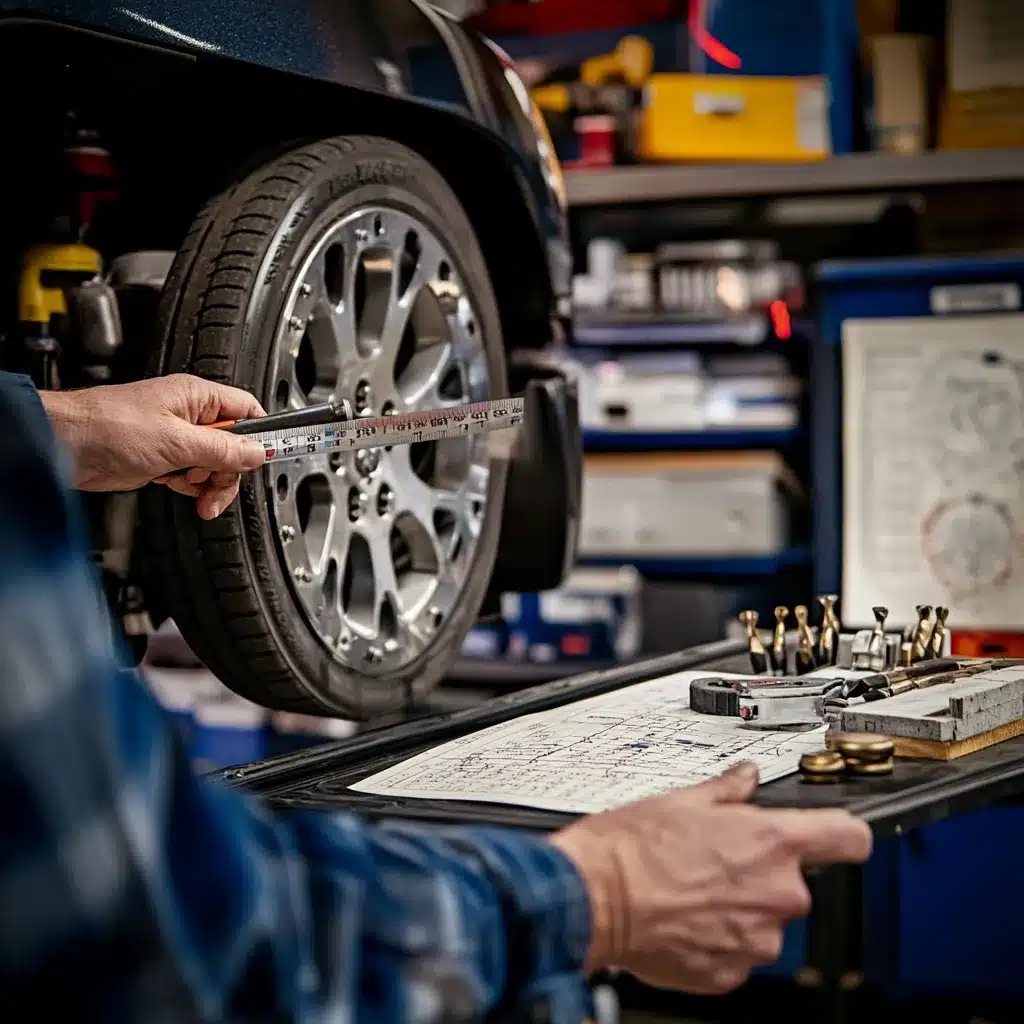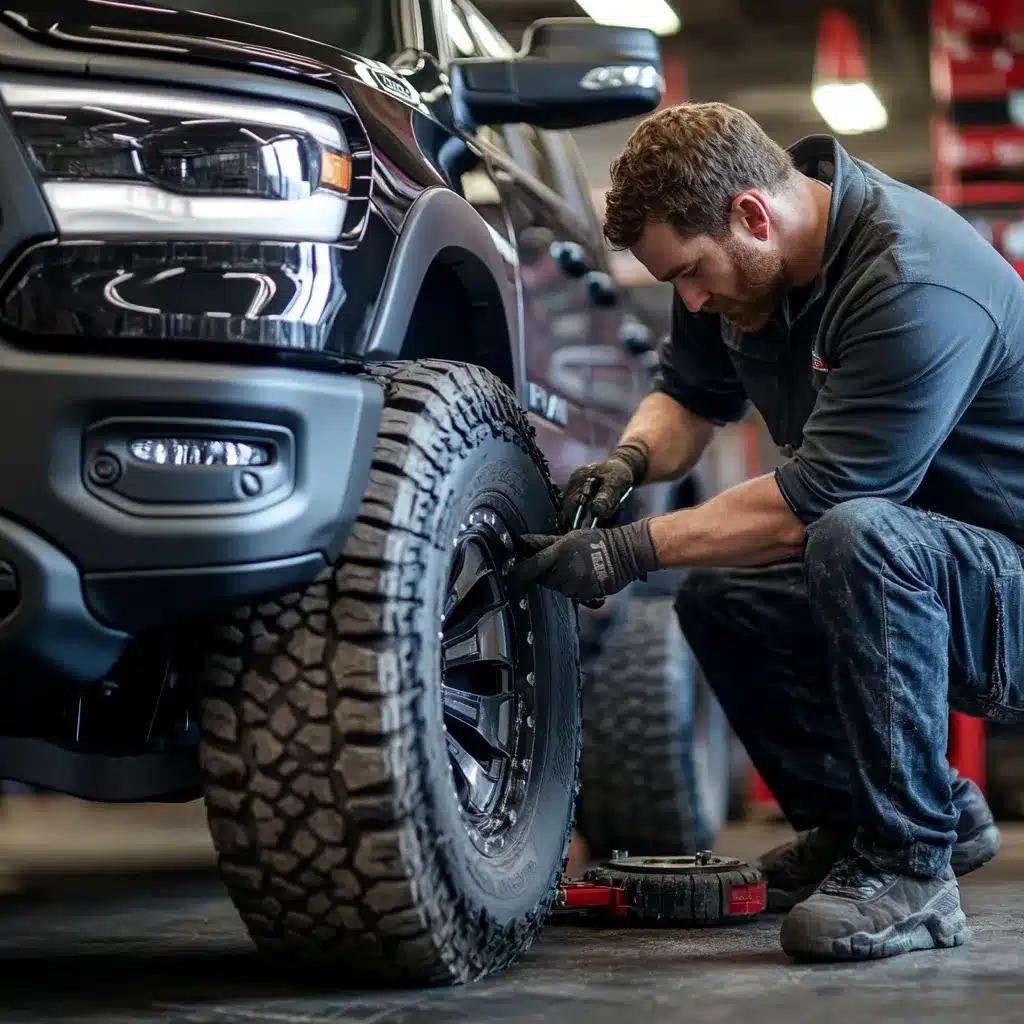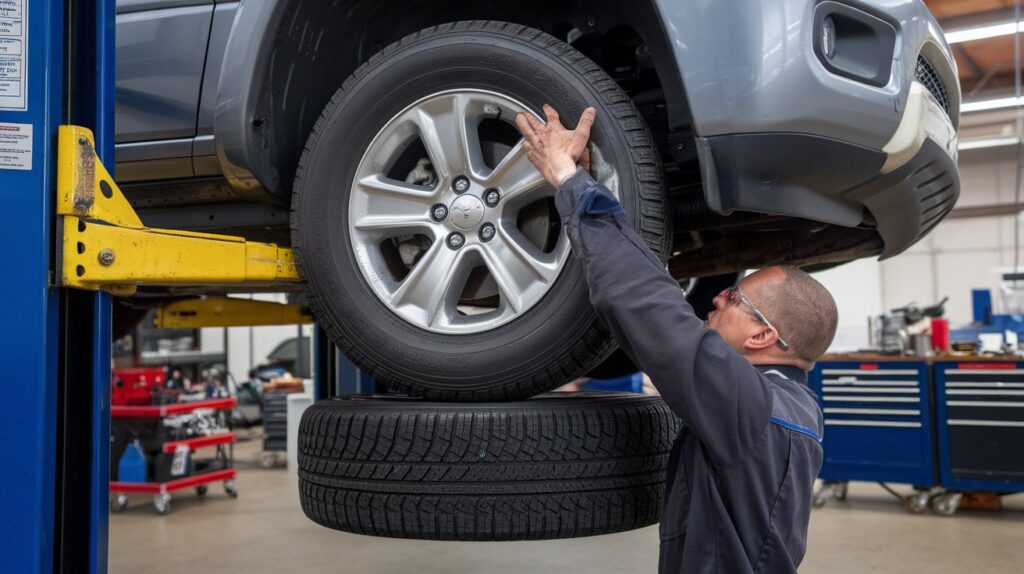Have you ever felt that unsettling wobble while cruising in your Dodge Ram 1500?
It might not be the road – your truck’s lug pattern could be the culprit.
This often-overlooked aspect of wheel maintenance is crucial for your Ram’s performance and safety on the road.
But don’t worry, you’re not alone in this. Many Ram 1500 owners underestimate the importance of proper lug pattern care.
The good news? Mastering this skill is easier than you think.
In this guide, we’ll unravel the mystery of lug patterns and show you how to check, maintain, and work with your truck’s specific setup.
From identifying your Ram’s unique pattern to choosing the right wheels, we’ve got you covered.
Let’s turn you into a lug pattern pro and keep your Ram 1500 smooth and steady.
Essential Maintenance Steps for Lug Patterns

Keeping your Dodge Ram 1500’s lug pattern in top shape is key to safe and efficient driving.
This section outlines the critical steps to maintain the integrity of your truck’s lug pattern.
From routine checks to professional inspections, each component is vital in ensuring your wheels stay securely attached and perform optimally.
Let’s dive into the specific maintenance tasks that will keep your Ram 1500 rolling smoothly for miles to come.
Regular lug nut inspections are a cornerstone of maintaining your Dodge Ram 1500’s wheel integrity.
These checks help ensure your wheels remain securely attached, preventing potentially dangerous situations on the road.
Let’s explore why these inspections are crucial, how to perform them effectively, and what to do with your findings.
Importance of Regular Inspections
Routine lug nut checks are more than just maintenance; they’re a safety measure.
By regularly inspecting your lug nuts, you can:
- Catch early signs of wear or loosening before they lead to wheel detachment
- Prevent uneven tire wear caused by improperly tightened lug nuts
- Extend the life of your wheels and tires
- Maintain optimal vehicle handling and performance
Neglecting these inspections can result in serious issues, from reduced fuel efficiency to catastrophic wheel failure while driving.
Regular checks also help you become familiar with your vehicle’s normal state, making it easier to spot changes or issues early on.
Common Issues to Look For
During your inspections, be on the lookout for:
- Visible rust or corrosion on lug nuts or surrounding areas
- Cracks or deformities in the lug nuts
- Signs of looseness, such as lug nuts that appear to be sitting at different heights
- Stripped threads on either the lug nuts or wheel studs
- Excessive dirt or debris buildup that could interfere with proper seating
- Unusual wear patterns on the wheel where it contacts the lug nuts
- Any signs of impact damage or bending in the wheel or lug nuts
Ignoring these signs can lead to wheel vibration, reduced handling capability, and, in extreme cases, wheel detachment while driving.
Each of these issues can compromise your safety and the longevity of your Ram 1500.
Step-by-Step Inspection Guide
To effectively inspect your lug nuts, follow these steps:
- Gather necessary tools: You’ll need a flashlight, a lug wrench, and torque wrench.
- Visually inspect each lug nut: Look for any visible signs of wear, damage, or looseness. Use your flashlight to get a clear view.
- Check for proper seating: Each lug nut should be flush against the wheel. Any that sticks out or sit at an angle may be loose or improperly installed.
- Perform a manual check: Using your lug wrench, gently attempt to tighten each nut. It may be loose and require proper tightening if it moves more than a tiny fraction.
- Look for signs of movement: Look for rust streaks or marks around the lug nuts, which indicate they’ve been moving.
- Inspect the wheels: While you’re checking the lug nuts, also look at the overall condition of your wheels for any signs of damage or wear.
Addressing Your Findings
If you find loose lug nuts:
- Use a torque wrench to tighten them to the manufacturer’s specifications (typically 130-140 ft-lbs for most Ram 1500 models).
- Tighten in a star pattern for an even distribution of force.
- Recheck after 50-100 miles of driving.
If you spot damaged or severely corroded lug nuts:
- Replace them immediately with new ones that meet your Ram 1500’s specifications.
- Consider replacing the entire set if one shows significant wear, as others may soon follow.
For any issues you’re unsure about or if you notice consistent loosening, consult a professional mechanic.
They can identify underlying issues that might not be apparent during a basic inspection.
Importance of Applying the Correct Torque
Proper torque application is crucial for maintaining your Dodge Ram 1500’s lug pattern integrity.
This section focuses on the specifics of torque application and its importance.
Torque Specifications for Dodge Ram 1500
Torque specifications vary by model year:
- 2011-2018 models: 130 ft-lbs (176 Nm)
- 2019 and newer models: 140 ft-lbs (190 Nm)
Always verify these specifications in your owner’s manual, especially for special editions or modified vehicles.
Importance of Correct Torque
Proper torque application ensures:
- Wheels remain securely attached to the vehicle
- Even distribution of force across all lug nuts
- Prevention of damage to wheel studs, lug nuts, and brake rotors
- Optimal wheel performance and longevity
Torque Application Process
- Prepare the vehicle:
- Ensure it’s on level ground with the parking brake engaged
- Clean the wheel hub and lug nut surfaces to remove any debris
- Apply torque in stages:
- Hand-tighten all lug nuts to ensure they’re properly seated
- Using a torque wrench, tighten to 50% of the specified torque
- Then tighten to 75% of the specified torque
- Finally, tighten to the full specified torque
- Use a star or cross pattern for even distribution of force
- Verify the torque:
- Double-check each lug nut in the same pattern
- Ensure the wrench indicates the correct torque without further rotation of the nut
Tire Rotation: Maintain the Even Wear of Tyres
Tire rotation is a crucial aspect of vehicle maintenance that directly impacts the integrity of your Dodge Ram 1500’s lug pattern.
By regularly rotating your tires, you ensure even wear across all four wheels, which not only extends tire life but also maintains consistent pressure on lug nuts and wheel studs.
This practice helps preserve the lug pattern’s integrity by preventing uneven stress distribution that can occur when tires wear unevenly.
Regular tire rotation contributes to lug pattern integrity in several ways:
- Evens out tire wear, ensuring balanced weight distribution
- Prevents uneven stress on wheel studs and lug nuts
- Allows early detection of potential lug nut or wheel stud issues
- Maintains consistent torque across all wheels
Recommended Tire Rotation Intervals
For most Dodge Ram 1500 owners, the general rule is:
- Rotate tires every 5,000 to 8,000 miles
- Or every 6 months, whichever comes first
However, you may need more frequent rotations if:
- You frequently drive on rough or unpaved roads
- Your truck carries heavy loads regularly
- You notice uneven tire wear before the recommended interval
Preparing for Tire Rotation
Essential tools for tire rotation include:
- Jack and jack stands rated for your Ram 1500’s weight
- Lug wrench or socket set
- Torque wrench
- Wheel chocks
Safety precautions:
- Park on a flat, level surface
- Engage the parking brake
- Use wheel chocks on the wheels not being lifted
- Never rely solely on a jack; always use jack stands
Step-by-Step Tire Rotation Process
- Lifting the Vehicle:
- Consult your owner’s manual for proper jack points
- Lift one side of the vehicle at a time
- Place jack stands under appropriate support points
- Rotating the Tires: For a Ram 1500 with same-size, non-directional tires:
- Move front tires straight back
- Move rear tires diagonally to the front
For directional tires:
- Swap front and rear tires on the same side
- Reattaching and Torquing Lug Nuts:
- Hand-tighten lug nuts in a star pattern
- Lower the vehicle until tires touch the ground
- Use a torque wrench to tighten to the specified torque (typically 130-140 ft-lbs for Ram 1500)
- Follow the torque sequence outlined in your manual
Troubleshooting and Addressing Common Issues

Maintaining your Dodge Ram 1500’s lug pattern isn’t always smooth sailing.
Even with regular care, issues can arise that need prompt attention.
This section will guide you through identifying and addressing common problems related to your truck’s lug pattern.
By learning to spot these issues early and understanding how to handle them, you’ll be better equipped to keep your Ram 1500 running safely and efficiently.
We’ll cover everything from diagnosing unusual noises and vibrations to dealing with stripped lug nuts or damaged wheel studs.
Remember, while many issues can be resolved with DIY methods, some problems may require professional attention to ensure your vehicle’s safety and performance.
1. Cross-Threading: Prevention and Solutions
Cross-threading is a distinct issue that can cause significant damage to your wheel studs and compromise wheel security.
Preventing Cross-Threading
- Always start lug nuts by hand for the first few turns, feeling for smooth threading
- Ensure the wheel is flush against the hub before tightening, checking for debris or corrosion
- Use a telescoping lug wrench for better control and feel, especially useful for reaching lug nuts on lifted trucks
- Avoid using impact wrenches for initial tightening, as they can easily cause cross-threading
Dealing with Cross-Threaded Lug Nuts
If you suspect cross-threading:
- Remove the lug nut carefully, noting any resistance
- Inspect both nut and stud threads for damage, looking for shiny metal or deformed threads
- Use a thread chaser to clean minor thread damage, working carefully to avoid further harm
- Replace both nut and stud if damage is severe, ensuring proper fitment
- Consider having a professional assess the wheel hub for potential damage
2. Identifying and Repairing Wheel Hub Damage
Wheel hub issues can seriously affect your Ram 1500’s performance and lug pattern integrity.
Unique Signs of Hub Damage
- Grinding noise that changes with vehicle speed, often more noticeable when turning
- ABS warning light on the dashboard, indicating potential sensor issues related to the hub
- Grease leakage around the hub area, suggesting seal failure
- Uneven brake pad wear, which can result from a worn hub allowing excess wheel movement
Hub Repair Considerations
- Check wheel bearing play using a dial indicator, looking for movement exceeding manufacturer specifications
- Inspect brake rotor surface for scoring, which can indicate hub misalignment or bearing failure
- When replacing a hub, always replace the wheel bearing as well to ensure optimal performance
- After hub replacement, perform a thorough alignment check, as hub issues can affect overall wheel alignment
- Consider upgrading to a higher quality hub assembly if you frequently drive in harsh conditions
Advanced Maintenance Tips and Seasonal Adjustments

As a Dodge Ram 1500 owner, understanding advanced maintenance techniques and seasonal considerations can significantly enhance your vehicle’s performance and longevity.
This section delves into specialized care for your truck’s lug pattern, taking into account varying weather conditions and potential upgrades.
1. Seasonal Lug Pattern Maintenance
Adapting your maintenance routine to seasonal changes is crucial for optimal performance and safety:
Winter Considerations
- Increased frequency of lug nut checks due to road salt and temperature fluctuations
- Use of anti-seize compound on lug studs to prevent corrosion (apply sparingly to avoid affecting torque)
- More frequent cleaning of wheels and lug nuts to remove salt buildup
Summer Adjustments
- Monitor lug nut torque more closely during extreme heat, as metal expansion can affect tightness
- Pay extra attention to tire pressure, as it affects overall wheel and lug nut stress
- Increase inspection frequency if engaging in more off-road activities during summer months
Transition Periods
- Perform a thorough inspection of lug nuts and wheel hubs during seasonal tire changes
- Re-torque lug nuts after the first 100 miles following a seasonal tire change
2. Professional Maintenance and Upgrades
While regular DIY maintenance is valuable, certain situations call for professional expertise:
When to Seek Professional Help
- If you notice consistent loosening of lug nuts despite proper torquing
- When experiencing persistent vibrations or unusual noises from the wheel area
- For annual comprehensive inspections of wheel bearings and hub assemblies
- If you suspect any warping or damage to the wheel hub surface
Upgrade Considerations
- Titanium lug nuts: Offer increased durability and resistance to corrosion
- Wheel studs with larger diameter: Can provide better thread engagement and strength
- Aftermarket wheels: Ensure they meet or exceed OEM specifications for load rating and offset
Professional Upgrade Process
- Consultation with a specialist to determine the best upgrades for your driving habits
- Professional installation to ensure proper fitment and torque application
- Post-upgrade inspection and test drive to verify performance
Final Thoughts
Imagine cruising down the highway, confident that your Ram 1500’s wheels are as secure as Fort Knox.
That’s the peace of mind proper lug pattern maintenance brings.
We’ve journeyed through the nuts and bolts of keeping your truck’s wheels where they belong – firmly on the road.
From tackling cross-threading gremlins to outsmarting seasonal challenges, you’re now armed with the know-how to keep your Ram rolling smoothly.
Remember, a little attention goes a long way in preventing major headaches.
So, the next time you hear a mysterious rattle or feel an odd vibration, you’ll know exactly what to do.
Ready to put your new skills to the test? Your Ram 1500 is waiting for some TLC.
Happy wrenching, and here’s to many safe miles ahead!


